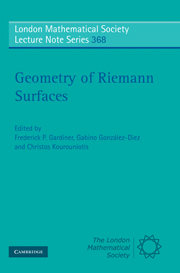Book contents
- Frontmatter
- Contents
- Preface
- Foreword
- Semisimple actions of mapping class groups on CAT(0) spaces
- A survey of research inspired by Harvey's theorem on cyclic groups of automorphisms
- Algorithms for simple closed geodesics
- Matings in holomorphic dynamics
- Equisymmetric strata of the singular locus of the moduli space of Riemann surfaces of genus 4
- Diffeomorphisms and automorphisms of compact hyperbolic 2-orbifolds
- Holomorphic motions and related topics
- Cutting sequences and palindromes
- On a Schottky problem for the singular locus of A5
- Non-special divisors supported on the branch set of a p-gonal Riemann surface
- A note on the lifting of automorphisms
- Simple closed geodesics of equal length on a torus
- On extensions of holomorphic motions—a survey
- Complex hyperbolic quasi-Fuchsian groups
- Geometry of optimal trajectories
- Actions of fractional Dehn twists on moduli spaces
A survey of research inspired by Harvey's theorem on cyclic groups of automorphisms
Published online by Cambridge University Press: 05 May 2013
- Frontmatter
- Contents
- Preface
- Foreword
- Semisimple actions of mapping class groups on CAT(0) spaces
- A survey of research inspired by Harvey's theorem on cyclic groups of automorphisms
- Algorithms for simple closed geodesics
- Matings in holomorphic dynamics
- Equisymmetric strata of the singular locus of the moduli space of Riemann surfaces of genus 4
- Diffeomorphisms and automorphisms of compact hyperbolic 2-orbifolds
- Holomorphic motions and related topics
- Cutting sequences and palindromes
- On a Schottky problem for the singular locus of A5
- Non-special divisors supported on the branch set of a p-gonal Riemann surface
- A note on the lifting of automorphisms
- Simple closed geodesics of equal length on a torus
- On extensions of holomorphic motions—a survey
- Complex hyperbolic quasi-Fuchsian groups
- Geometry of optimal trajectories
- Actions of fractional Dehn twists on moduli spaces
Summary
Abstract
In 1966 Harvey found necessary and sufficient conditions on the signature of a Fuchsian group for it to admit a smooth epimorphism onto a cyclic group. As a consequence, he solved the minimum genus and the maximum order problems for the family of cyclic groups (the latter already solved by Wiman). This was a seminal work in the study of groups of automorphisms of compact Riemann surfaces. Since then, much research has been conducted to extend Harvey's theorem to other classes of finite groups and, in particular, to solve the minimum genus and maximum order problems for these classes. In this survey we present some results obtained so far.
Introduction
In 1966 Bill Harvey published Cyclic groups of automorphisms of a compact Riemann surface in the Quarterly Journal of Mathematics, [Har]. The main result in it gives necessary and suficient conditions on the signature of a Fuchsian group for it to admit a smooth epimorphism onto a cyclic group. This allowed him to solve the minimum genus and the maximum order problems for the family of cyclic groups, although the latter had already been solved by Wiman [Wim]. Some years earlier, at the beginning of the sixties, A. M. Macbeath [Mcb1] revisited the Poincaré uniformization theorem and settled the basis of the combinatorial study of compact Riemann surfaces and their groups of automorphisms. This combinatorial point of view opened the door to a fruitful research, subsequently developed by Macbeath's students Bill Harvey, Colin Maclachlan and David Singerman.
- Type
- Chapter
- Information
- Geometry of Riemann Surfaces , pp. 15 - 37Publisher: Cambridge University PressPrint publication year: 2010
- 2
- Cited by



